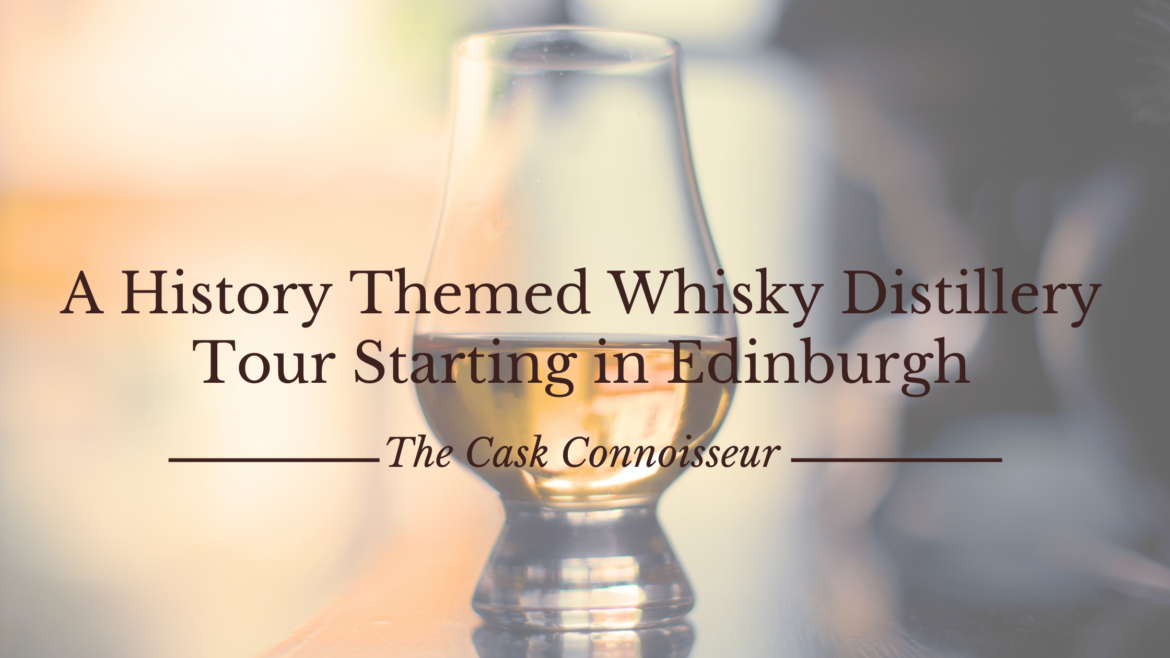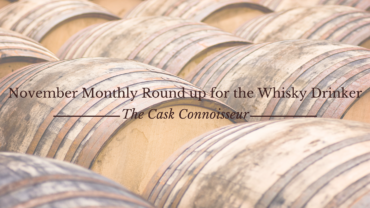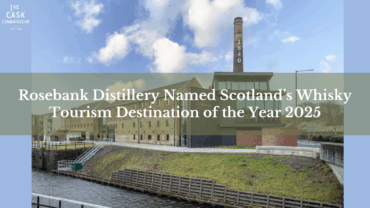Edinburgh is a good place to base yourself these days if you want to indulge in whisky. Not only are there a couple of distilleries to visit within the city (Holyrood, Port of Leith) but plenty more within easy driving distance (Glenkinchie, Eden Mill, Lindores, Rosebank, Tullibardine, Deanston, Glenturret, Borders and Glengoyne all do tours). Two visitors experiences (Johnnie Walker, The Scotch Whisky Experience), numerous specialist whisky bars and shops.
This history based tour visits two distilleries in distinct environments allowing time to explore the rural and historical landscape of the Kingdom of Fife (Lindores) or the post-industrial and historical landscape of the central belt of Scotland (Rosebank).
Lindores Abbey Distillery
Lindores Abbey distillery sits on the southern bank of the Firth of Tay in the small town of Newburgh in the Kingdom of Fife which derives from the Pictish name of Fib. The distillery cost £10 million to build and opened in 2018 with production of whisky starting on 5th October that year. It is adjacent to the ruins of Lindores Abbey where an entry in the Exchequer role of 1494 says “To Friar John Cor, 8 bolls of Malt, wherewith to make Aqua Vitae for King James IV” being the first written mention of the making of scotch whisky. Lindores might make claim to being the spiritual home of scotch whisky and therefore an obligatory pilgrimage for whisky fans. You will be following in the footsteps of many medieval pilgrims on their way to St Andrews the purported resting place of St Andrew.
The distillery sits adjacent to the ruins of the Abbey to the north, a new housing estate to the south and Lindores hill to the east with an outline of the “bear and ragged staff” marked on it. Quite what the symbol of the Earls of Warick has to do with Newburgh and Lindores Abbey is anyone’s guess, as there is no clear historical link, but there is an association. Hence the outline on the hillside due to the distillery’s annual Bear Burning Event in May, only open to their 1494 members, and the use of the symbol in the distillery’s logo.
Basic tour information
Tours take place between 10.00am and 4.00pm with booking preferable. All information is available on their website. If you require refreshment beyond tea, coffee and cold drinks you can pre-book various platters giving 48 hours’ notice. The standard tour costs £15 with two drams to taste at the end. Driver packs are also available. You can also book additional whisky flights starting from £12.50. There is full wheel-chair access and dogs are also welcome. If you are a group, it is worth speaking with the staff prior to booking as they can “tailor make” your visit. Tours for groups start from £30 but are private. The distillery also offers experiences including paired chocolate tasting, private dining and crafting your own unique spirit.
On the Day
Not having booked, there was no suitable tour time available but an enjoyable hour or two was spent in discussion with Matt regarding the distillery and the history of the Abbey, a perusal of the “history room”, the shop, and of course a tour of the Abbey.
The highlight of our discussion was being able to sample a Bourbon cask bottled for private cask members in 2024. Made using a Woodford Reserve single cask, 6 years old, 60% ABV, £65. At 60% it was surprising how good it was as the first dram of the day. It almost made us want to buy a cask just to get access to it. The official notes describe honey, caramel ,coconut, bourbon, and spicy wood. All were found except coconut until we discussed the official notes. Perhaps adding some water would have made the coconut more available?
Since we are not Cask members this bottle was not available to us, the nearest being their The Makar’s Malt II 55% ABV, £69, one of 481 bottles, a bottle was duly bought along with another bottle of Thiron (annual limited edition, 49.4% ABV, £63) both released during 2024. For The Cask Connoisseur, Thiron marked the coming of age of Lindores and is a cracking bottle well worth the price.
Lindores Abbey required a bit of imagination to work out its layout and it was only afterwards that it’s and Newburgh’s historical significance came to light. It is well worth downloading and reading a free copy of the Victorian Antiquarian, Alexander Laing’s Lindores Abbey and its Burgh of Newburgh where you’ll discover connections to Wallace, Edward I, Robert the Bruce, Cromwell, other members of the Scottish Royal Family and the Abbey’s downfall during the Reformation. The distillery’s website does provide a brief history. Perhaps the most poignant on the day was viewing the small stone caskets labelled “Princes Coffins” and afterwards thinking about Wallace entering through the “Slype Gate” after the battle of Blackearnside.
Rosebank Distillery
Rosebank opened in 1840 on the banks of the Forth & Clyde canal, the superhighway of its day between Edinburgh and Glasgow. Rosebank’s founder was James Rankine who passed it on to his son who rebuilt it in 1868. It stayed within the family until the First World War when it passed to the Distillers Co. The distillery was closed in 1993 with the original copper stills being stolen in 2008. Before closure it was termed the “King of the Lowlands”. With its rescue by Ian Macleod Distillers in 2017, who also own Glengoyne and Tamdhu distilleries, new make spiritstarted flowing on the 5th June 2023. It once again has become a pilgrimage site for whisky enthusiasts.
Falkirk was once part of the Iron, Steel and Coal Triangle of Central Scotland with the giant Carron Ironworks a couple of miles away. This industrial powerhouse declined during the course of the 20th Century with little remaining of these heavy industries. The history of Falkirk stretches back to the Romans with the building of the Antonine Wall and a series of forts. The close by suburb of Camelon even might be connected to King Arthur. Today nearby tourist attractions include the Falkirk Tunnel, the Antonine wall, the Falkirk Wheel and the Kelpies. The first three can be explored with a four mile gentle walk along the Forth & Clyde canal towpath over a leisurely two hours. A good option for the driver if you’re not keen on whisky.
Basic tour information
The distillery is open 11.00am to 5.30 pm Thursday through Monday. There are three tours offered, Rosebank Reawakening £25 (every 90 minutes from 11.30 AM), Rosebank Rekindled £95 (at 11.30 am and 2.00pm) and Rosebank Revered £300 (2.15pm). The first two last around 90 minutes with the last being three hours. Booking is preferable. There is full wheelchair access but worth checking with staff first. Light refreshments are available. You can also book group visits (up to 56 people) and include private dining.
On the Day
The Cask Connoisseur chose the Rosebank Rekindled tour (£95) which including the tasting and further conversations with staff certainly filled more than a couple of hours! The best overview of the distillery site can be seen from the upper level of the car park, whilst the most iconic view is on the bridge over the canal. The tour takes you through not only the unique production process (three stills, each passing separately through the worm tubs and then to the spirit safe) but also the history. Apparently only Auchentoshan Distillery has the same set up.
What is clear from the tour is the effort taken to preserve as much of the history and fabric of the old distillery. They recycled as much of the original building materials as possible some obviously not in or for the original purposes. Some notes taken during the tour, so hopefully accurate:
- The three stills were crafted to the exact specification of the originals based on design documents found.
- Of the five original warehouses only one has survived.
- Water from the canal was used for the worm tub condensers.
- 27 tonnes of malted barley comes from Crisp Malts each week using local barley. The barley is ground in a Bobby Mill formerly used at Port Ellen which is 103 years old. The barley is ground to 22% husk, 68% grist and 10% flour.
- Water from the Carron reservoir is used in the mash.
- Fruity floral whisky wanted, similar in flavour to barley sugar sweets.
- There are 12 mashes per week producing 585 thousand litres per year
- Washbacks (8) hold up to 21000 litres, although each washback is usually filled to 15000 litres. This produces a wort at 8.5% ABV and fermentation takes 72 hours. The washbacks are Douglas fir and have a lifespan of 40 years. Wood is used for sustainability and adds nothing to the flavours.
- From the initial 15000 litres, after passing through the stills 1500 litres remains.
- The heart cur is taken between 80 – 73.5% ABV.
The tour finished with a dramatic flourish in the only original warehouse still standing. This houses the only casks left from the old Rosebank and the first casks from the modern. It was surprisingly impressive to see, a room to admire with reverence to old and new life.
For others the highlight of the tour might be tasting the 31 year old Rosebank along with new make spirit, Glengoyne 21 year old and Tamdhu 18 year old. Tasted in that order and accompanied with some rather good fudge.
On the day, the tasting notes were:
Rosebank 31 year old
Surprising how light and floral the dram was, possibly the lightest spirit ever tasted. It seemed to coat and evaporate across the whole mouth dancing across the palate on “the nimblest of feet”, somewhat describes the experience.
- The colour is light with an obvious oiliness demonstrated by the slow moving legs.
- The nose is herbal, grass, camomile.
- The palate continues mildly herbal but with an intriguing meatiness at the end similar to the experience of drinking Mortlach, but not as robust.
- Finish was short and light which might not be what you want from a sipping whisky, particularly if you like your sherry casks, but was all part of the unique experience. It is well worth taking time with this.
- The bottle costs around £1600 at the distillery so needs to be good. Is it worth it? Well, that works out at about £70 per dram. Definitely worth trying for the experience but it would be up to the individual to decide if worth the bottle cost.
New Make Spirit
An interesting second “dram” given the high ABV. What it did confirm is that the new stills certainly are producing a similar spirit. Overall, despite the high ABV, one got the impression of the same underlying light and floral spirit. It would seem the revived distillery will produce a pretty similar profile to the old Rosebank.
Glengoyne 21 year old
Made from 100% oloroso sherry casks and typical of older Glengoyne. Interestingly younger Glengoyne maybe as much as 50% ex-bourbon these days.
- The nose is fruit salad, apples and caramel toffee.
- Palate is a “sherry bomb” along with apples.
- Finish is long with notes of cinnamon.
Tamdhu 18 year old
This was voted the best dram on our tour and offers very good value if you’re into your sherry bombs. Well worth buying, and that from someone who is not into sherry cask whisky. Tamdhu is one of those distilleries which is not high up on your list to explore but is worthy of higher praise than it receives.
• Nose – sherry, chocolate and butter
• Palate – the sherry takes over, but it is thick and oily coating the whole palate. At the time it was difficult to identify individual flavours but certainly provided the best wow to this rather jaded palate.
• Finish was long as you’d expect from such a sherry bomb.
Final verdict on the two distilleries…
Really hard to decide which way round you should do this tour of two distilleries. On the one hand completely different but on the other both of significant historic interest to the whisky fan, admittedly for completely different reasons. Whichever way round you go, you will have a cracking day out.





